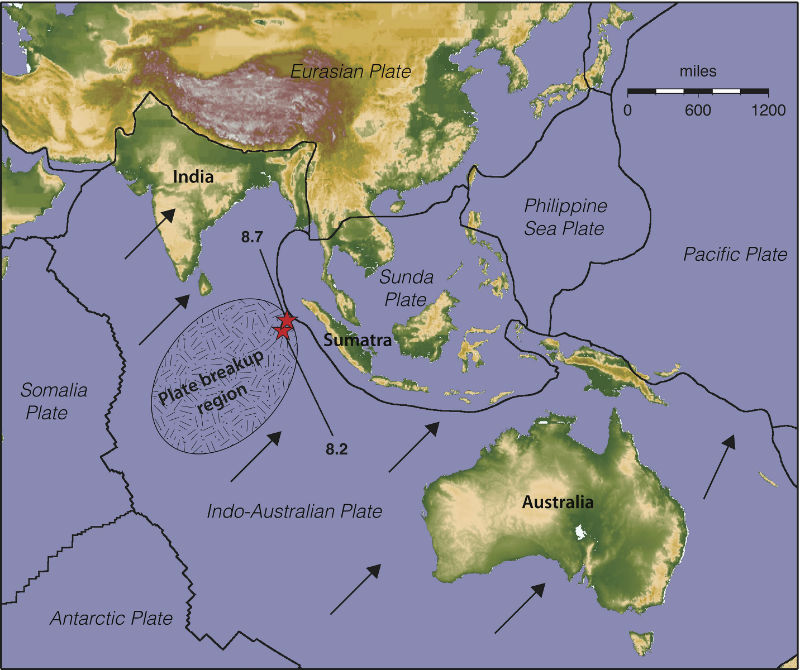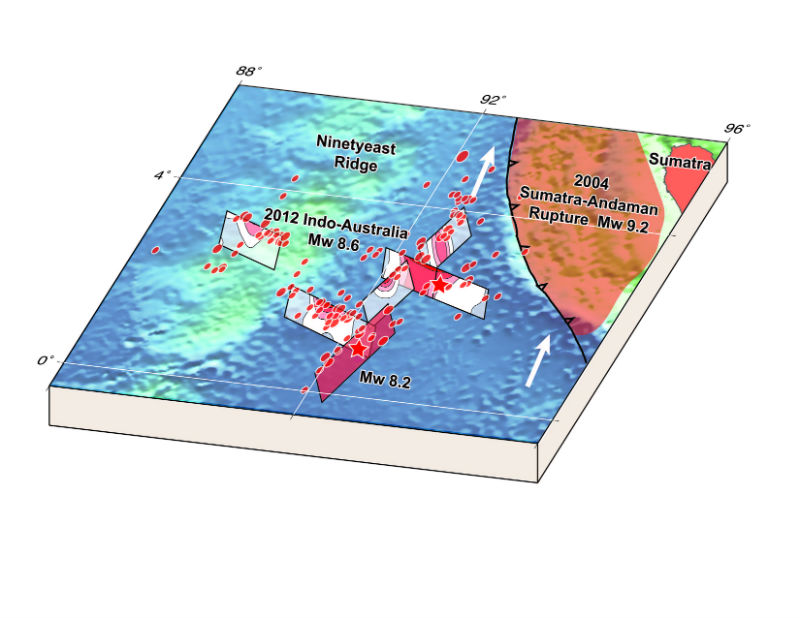Weird 2012 Quake Signals Tectonic Plate Birth


On the afternoon of April 11, 2012, one of the most powerful earthquakes ever recorded — and now revealed to be among the weirdest — struck in the Indian Ocean, off the coast of Sumatra. It's a region all too familiar with geological catastrophe.
Eight years earlier, in December 2004, the third largest earthquake on record had ripped through a nearby region of the ocean floor. The magnitude-9.1 earthquake and the monstrous tsunami that soon followed killed more than 227,000 people in 14 countries,
So when a magnitude-8.7 earthquake (some put the magnitude at 8.6) shook the Indonesian island on that Wednesday afternoon earlier this year, many expected the worst. Yet, no monster wave appeared. A wave did come ashore, but it was a miniature tsunami, just 12 inches (31 centimeters) high.
All told, the earthquake did very little damage — yet only five higher earthquake magnitudes have ever been recorded. So what was the deal? [Video: What Earthquake 'Magnitude' Means?]
New research published today (Sept. 26) in the journal Nature delves into the intimate details of this earthquake, along with the powerful, magnitude-8.2 quake that followed two hours later. The new studies add to an existing body of research that shows this was a remarkable event — one of the most surprising earthquakes ever recorded — and one that offers an unlikely snapshot of a geological process millions of years in the making.
Turning a corner
Data captured by a global network of seismometers on April 11 revealed almost immediately that this quake was a strike-slip earthquake — the sort that races along the San Andreas Fault. Strike-slip earthquakes occur when two sides of a fault jolt horizontally, displacing the ground sideways. Since these earthquakes don't shove the ocean floor upward — a required move for tsunami generation — no deadly wave appeared. [April 2012 Sumatra Quake (Infographic)]
Get the world’s most fascinating discoveries delivered straight to your inbox.
Tsunamis are typically the devastating handiwork of quakes known as subduction earthquakes. They're the most powerful earthquakes on the planet, and they occur at plate boundaries, where one tectonic plate is grinding inexorably beneath another. When the bottom plate suddenly lurches deeper, a colossal amount of energy is released, unleashing the sorts of massive earthquakes and calamitous tsunamis that hit the Indian Ocean in 2004 and the coast of Japan in March 2011. [7 Craziest Ways Japan's Earthquake Affected Earth]
It quickly became apparent that the April 11 earthquake was the most powerful strike-slip quake ever recorded. Which was strange.
Not only was the quake of unparalleled power, it hit in the middle of a tectonic plate, not at a plate boundary, like the San Andreas Fault. "So already it has two unusual attributes," said Thorne Lay, a professor of earth and planetary sciences at the University of California, Santa Cruz, and an author on one of the papers published today.
Lay and his team set out to construct a blow-by-blow account of how the earthquake progressed, and what they found added to the quake's mystique. This earthquake was able to turn corners.
"It's totally unusual," Lay told OurAmazingPlanet. It turns out that the quake began on one fault, streaking along at more than a mile per second, and, when it reached an intersecting fault, it ruptured that one, too. In all, it ruptured four different faults over the course of 150 seconds, unleashing an amount of energy equivalent to about four magnitude-8.0 earthquakes.
Lay said that, typically, when earthquakes spread to connecting faults, the rupture rips along faults that branch away from the initial fault like the branches of a river. These earthquakes raced along in a grid-like pattern, making 90-degree turns along faults that resemble a lattice.
"Here, they really do seem to go along perpendicular faults, and we haven't seen anything like that with a big earthquake," he said.
However, he said, the weird rupture pattern reflects the weird geological circumstances at play in the neighborhood where the earthquake hit. The April 11 earthquake occurred in a region that is giving birth to the Earth's newest tectonic plate.
Birth pangs
The earthquake hit in the middle of the Indo-Australian plate, a plate that is being torn asunder. And in fact, it is this process that helped trigger this astonishingly powerful earthquake. In a way, the area where it hit was primed for a major earthquake — scientists just had no idea how major such an earthquake could be.
"It's a pre-existing zone of weakness," said Matthias Delescluse, a marine geophysicist at Paris's Ecole Normale Supérieure and an author of another Nature paper on the earthquake published today.
The faults that the earthquake ruptured are, essentially, the bones of an ancient volcanic seam that once snaked across the ocean floor, giving rise to new crust. The system fell silent 45 million years ago, but the fractures it created in the tectonic plate are still there.
And this particular tectonic plate is undergoing some major stress, Delescluse told OurAmazingPlanet. "I like to represent it with the sidecar analogy," he said. Think of the Australia region of the plate as a motorbike, and the India region as a sidecar. Both are hurtling northward at a fast clip — for a tectonic plate at least — at about 2 inches (5 cm) per year.
"Now imagine the sidecar — not the motorbike — runs into a wall," Delescluse said. "The sidecar would compress, and the motor bike, depending on the violence of the shock, would finally detach from the sidecar."
That wall that our India sidecar is hitting is the Eurasian plate. The colossal collision has produced some impressive side effects: the Himalayas, the highest mountains on Earth. Australia is able to continue its progress largely unhindered, because that portion of the plate is diving under another tectonic plate — a process that produces the sort of massive earthquake that hit in 2004.
The evidence suggests that the Indo-Australian plate began to be ripped apart between 8 million and 10 million years ago. The 2012 earthquake is just one of many that have likely ripped along the same region since this process began.
After millions more years of similar earthquakes, the ruptures will begin to favor a particular path, giving rise to a new plate boundary, and separating today's existing plate into two.
Delescluse said that the singular earthquake measured in 2012 offers a glimpse of this process in unprecedented detail.
"This event is really illustrating what happened in the past and will happen in the future," he said.
Because the continental plates are built differently than oceanic plates, which are far more brittle, it's unlikely that such a colossal strike-slip quake could hit on land, Delescluse said.
Rare event?
A third paper published today shows that the April 11 earthquake likely triggered earthquakes around the world for a short time afterward.
Together, the papers offer an unprecedented look at the geological setup for the earthquake, how it unfolded second by second, and its aftermath.
"The fact that within six months we have understood this much — that is really quite impressive," said Hiroo Kanamori, a professor emeritus at Caltech, and a revered figure among geophysicists. He was not involved in the research.
Kanamori, who has studied large earthquakes for decades, said that vast improvements in both the quality and quantity of instruments, and of methodology, has allowed the science to make unprecedented strides forward.
"If this had happened 40 years ago, it would have taken a few years to even understand what it was," he told OurAmazingPlanet.
And although he said the event certainly was surprising, he noted that it's only surprising from the perspective of a human lifetime — "not on the geological time scale," he said.
Lay echoed Kanamori's long-term perspective.
"When you're dealing with a process that may be taking millions of years, we're getting a very short window of observation from which to make generalizations about the past," he said. "Astronomers can look farther away, and they can see farther back in time — we see what we see today," he said. And the Earth may have more geological surprises in store, he said.
Reach Andrea Mustain at amustain@techmedianetwork.com, or follow her on Twitter @AndreaMustain.Follow OurAmazingPlanet on Twitter @OAPlanet. We're also on Facebook & Google+.



